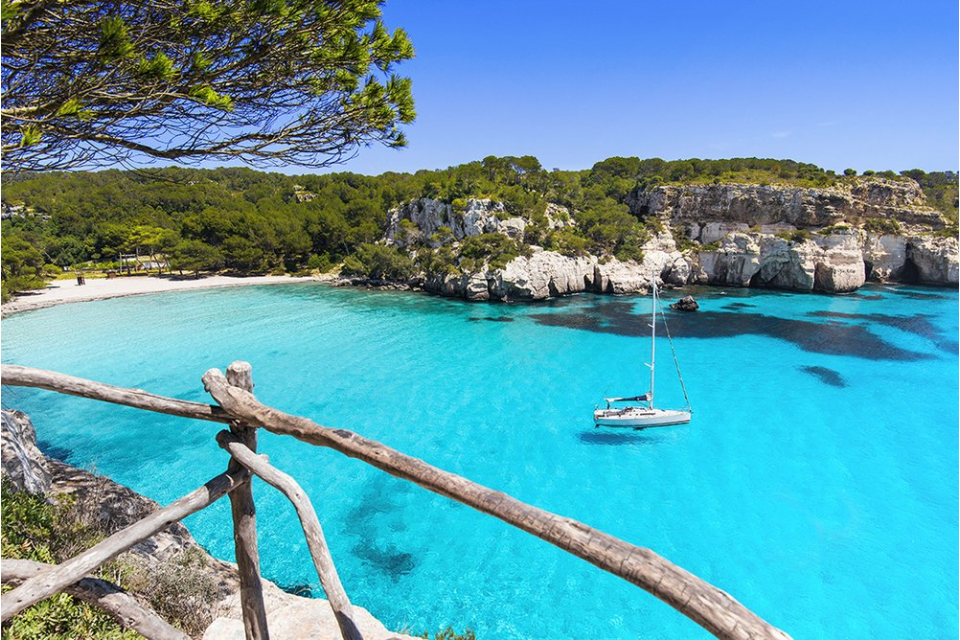¿Te gustaría visitar las playas de España pero ya conoces las más típicas? ¡Entonces sigue leyendo! En esta lectura te mostraremos algunas de las playas más maravillosas y menos conocidas por los turistas.
PLAYA DE OYAMBRE Y LA RABIA
Si has leído nuestra lectura anterior sobre la división territorial de España, ya sabrás dónde se encuentra Cantabria, en el norte de España. En esta comunidad autónoma, en el corazón del Parque Natural de Oyambre, encontramos dos playas que no dejan indiferente a nadie: las playas de Oyambre y La Rabia.

Estas playas son perfectas para toda la familia porque, aunque son casi vírgenes y aisladas, puedes aparcar tu coche cerca y habrá un socorrista vigilando. Además, es un lugar muy visitado por los amantes del avistamiento de aves y de las playas de arena fina y dorada.
MACARELLA Y MACARELLETA, ISLAS BALEARES
No es fácil elegir solo una playa en Menorca, Islas Baleares, ya que toda la costa de esta preciosa isla está llena de pequeñas joyas. Esta en concreto, está considerada como una de las playas más bonita de la zona, totalmente paradisíaca.

Se trata de una cala virgen con forma de U y de tamaño mediano que no puede acoger demasiada gente. Solo 300 metros la separan de Macarelleta, más escondida y pequeña.
Su entorno acoge una gran vegetación de pinares frondosos y una amplia variedad de fauna marina en sus aguas.
El acceso a estas playas puede hacer tanto en coche como a pie, aunque las rutas a pie no son para todos los públicos ya que los caminos suelen ser salvajes.
PLAYA DE NOGALES, ISLAS CANARIAS
Es una de las mejores de La Palma, Islas Canarias, pues sintetiza buena parte de lo que ofrece la isla: montañas, senderos, lava, océano y mucha vegetación. Su negra arena volcánica, su espectacular acantilado y su poderoso Océano Atlántico hacen que sea ideal para surferos, naturistas o amantes de los paisajes y paseos.

Esta es una zona completamente virgen y salvaje ; no hay ni restaurantes, ni bares a la vista, por lo que es imprescindible llevar suficiente agua y comida.
Puedes aparcar tu coche en lo alto del acantilado y caminar 15 minutos por el sendero, pero debes saber que hay que subir y bajar muchos escalones hasta llegar a la playa, y lo mismo a la vuelta, no existe otra forma más fácil de acceder.
¿Qué esperas para conocerlas?
22. EL VOLCÁN DE LA PALMA EN ERUPCIÓN
La Palma es una de las islas Canarias más pequeñas de España, ubicada frente a la costa oeste de Marruecos.

El 19 de septiembre de 2021 el volcán Cumbre Vieja erupcionó, sembrando el miedo entre los habitantes de la pequeña isla. Esta semana, el día 25 de enero, se cumple un mes desde que los científicos afirmaron que la erupción había llegado a su fin. Tras 85 días y 8 horas, finalizó su actividad de lava, gases y otros elementos.
La actividad del volcán ha dejado miles de personas sin hogar, unos 1.200 hogares fueron arrasados. Además, las coladas de lava destruyeron cientos de hectáreas y enterraron con ceniza las zonas contiguas, convirtiendo así algunos lugares en grandes desiertos. En total, la lava ha destruido 1.134 hectáreas, un tercio de las cuales eran tierras de cultivo, en su mayoría árboles plataneros y aguacateros vitales para la economía de la isla.
Cuando la lava comenzó a llegar a la costa oeste de la isla, cayendo desde los acantilados al océano Atlántico y agregando 48 hectáreas de lava al fondo marino, sucedió lo temido por los expertos: millones de organismos marinos quedaron sepultados bajo la lava.
Sin embargo, lo que en un primer momento supuso la destrucción de la vida marina en la zona más tarde generará un ecosistema marino más rico y productivo gracias a los nuevos nutrientes depositados:
“Esos compuestos de sílice, aluminio, hierro, magnesio o calcio llegan al mar y ahí sufren un proceso de alteración por el agua, que va liberando estos compuestos y lógicamente también va dotando de muchos nutrientes para que se vaya desarrollando más vida submarina”, confirma María José Huertas, experta petróloga.
Afortunadamente, este desastre natural ha llegado a su fin y los habitantes de La Palma pueden volver a respirar sin utilizar mascarillas especiales que filtren los gases del volcán. Por el contrario, las pérdidas personales, económicas y ambientales han sido enormes y el proceso de recuperación será lento y costoso.
Would you like to visit the beaches of Spain but you already know the most typical ones? Then read on! In this reading we will show you some of the most wonderful beaches and less known by tourists.
OYAMBRE BEACH AND RAGE
If you have read our previous post about the territorial division of Spain, you already know where Cantabria is located, in the north of Spain. In this autonomous community, in the heart of the Oyambre Natural Park, we find two beaches that leave no one indifferent: the beaches of Oyambre and La Rabia.

These beaches are perfect for the whole family because, although they are almost virgin and isolated, you can park your car nearby and there will be a lifeguard on duty. In addition, it is a place much visited by lovers of bird watching and fine golden sand beaches.
MACARELLA AND MACARELLETA, BALEARIC ISLANDS
It is not easy to choose just one beach in Menorca, Balearic Islands, since the entire coast of this beautiful island is full of little gems. This one in particular is considered one of the most beautiful beaches in the area, totally paradisiacal.

It is a virgin, U-shaped cove of medium size that cannot accommodate too many people. Only 300 meters separate it from Macarelleta, which is more hidden and smaller.
Its environment is home to a great vegetation of leafy pine forests and a wide variety of marine fauna in its waters.
Access to these beaches can be done both by car and on foot, although the routes on foot are not for everyone as the paths are usually wild.
NOGALES BEACH, CANARY ISLANDS
It is one of the best in La Palma, Canary Islands, as it synthesizes a good part of what the island offers: mountains, trails, lava, ocean and lots of vegetation. Its black volcanic sand, its spectacular cliffs and its powerful Atlantic Ocean make it ideal for surfers, naturists or lovers of landscapes and walks.

This is a completely virgin and wild area; There are no restaurants or bars in sight, so it is essential to bring enough water and food.
You can park your car at the top of the cliff and walk 15 minutes along the path, but you should know that you have to go up and down many steps to reach the beach, and the same on the way back, there is no other easier way to access.
What are you waiting to meet them?
THE ERUPTING VOLCANO OF LA PALMA
La Palma is one of the smaller Canary Islands in Spain, located off the west coast of Morocco.

On September 19, 2021, the Cumbre Vieja volcano erupted, sowing fear among the inhabitants of the small island. This week, on January 25, marks a month since scientists said the eruption had come to an end. After 85 days and 8 hours, its activity of lava, gases and other elements ended.
The activity of the volcano has left thousands of people homeless, some 1,200 homes were razed. In addition, the lava flows destroyed hundreds of hectares and buried the adjoining areas with ash, thus turning some places into large deserts. In total, the lava has destroyed 1,134 hectares, a third of which was farmland, mostly banana and avocado trees vital to the island’s economy.
When the lava began to reach the west coast of the island, falling from the cliffs into the Atlantic Ocean and adding 48 hectares of lava to the seabed, what experts feared happened: millions of marine organisms were buried under the lava.
However, what at first meant the destruction of marine life in the area will later generate a richer and more productive marine ecosystem thanks to the new nutrients deposited:
“These compounds of silica, aluminium, iron, magnesium or calcium reach the sea and there they undergo a process of alteration by the water, which releases these compounds and logically also provides many nutrients so that more underwater life develops”, confirms María José Huertas, expert petrologist.
Fortunately, this natural disaster has come to an end and the inhabitants of La Palma can breathe again without using special masks that filter the gases of the volcano. On the contrary, the personal, economic and environmental losses have been enormous and the recovery process will be slow and costly.





